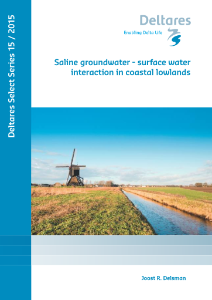Joost Delsman (2015) Saline groundwater – surface water interaction in coastal lowlands
VU University Amsterdam, 194 pp.
Saline groundwater – surface water interaction in coastal lowlands
Joost Delsman
Het onderzoek van Joost richtte zich op de uitspoeling van zout grondwater naar oppervlaktewater. Metingen in de Haarlemmermeer en de Schermer hebben ons meer geleerd over de grote variatie in ruimte en tijd in het zoutgehalte van poldersloten, veroorzaakt door een sterk wisselende uitstroom van zout grondwater naar het oppervlaktewater. Deze kennis heeft geleid tot een snel wiskundig model om zoutconcentraties te voorspellen, en tot concrete adviezen voor zoetwaterbeheer en de huidige praktijk van doorspoelen. Het onderzoek heeft ons ook meer begrip opgeleverd van de belangrijke rol die de Holocene landschapsontwikkeling heeft gespeeld in het vóórkomen van zout grondwater in het Nederlandse kustgebied. Hiermee zijn we beter in staat de huidige verdeling van zoet en zout grondwater te bepalen, en kunnen we beter voorspellen hoe deze verdeling in de toekomst zal veranderen. Download het proefschrift hier.
Saline groundwater exfiltration is a common problem in the coastal zone of the Netherlands, but the hydrological processes and physiographic factors that affect this are not fully understood. The research presented in this thesis aims to identify the processes and physiographic factors controlling the spatial variability and temporal dynamics of the exfiltration of saline groundwater to surface water, and hence the contribution of saline groundwater to surface water salinity. Topics covered include a paleo-hydrogeological model simulation of the Holocene evolution of groundwater salinity as a result of paleo-geographic changes; surface water salinity dynamics in a densely-drained lowland catchment; hydrograph separation in an agricultural catchment; observations of heads, flow, solute concentration and temperature to constrain a detailed, variable-density groundwater flow and transport model; and a model to simulate the salinity dynamics of exfiltrating groundwater to support operational water management of freshwater resources in coastal lowlands. The thesis further outlines the implications of these findings for freshwater management in the Netherlands. It demonstrates that the salinity of groundwater exfiltrating in polders in the Netherlands, and hence surface water salinity, varies on a wide range of spatial and temporal scales. Download here
Saline groundwater exfiltration is a common problem in the coastal zone of the Netherlands, but the hydrological processes and physiographic factors that affect this are not fully understood. The research presented in this thesis aims to identify the processes and physiographic factors controlling the spatial variability and temporal dynamics of the exfiltration of saline groundwater to surface water, and hence the contribution of saline groundwater to surface water salinity.
Topics covered include a paleo-hydrogeological model simulation of the Holocene evolution of groundwater salinity as a result of paleo-geographic changes; surface water salinity dynamics in a densely-drained lowland catchment; hydrograph separation in an agricultural catchment; observations of heads, flow, solute concentration and temperature to constrain a detailed, variable-density groundwater flow and transport model; and a model to simulate the salinity dynamics of exfiltrating groundwater to support operational water management of freshwater resources in coastal lowlands. The thesis further outlines the implications of these findings for freshwater management in the Netherlands. It demonstrates that the salinity of groundwater exfiltrating in polders in the Netherlands, and hence surface water salinity, varies on a wide range of spatial and temporal scales.
